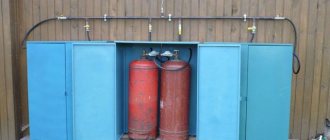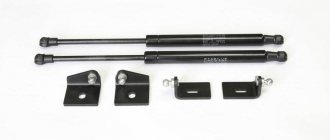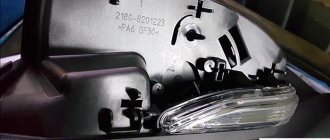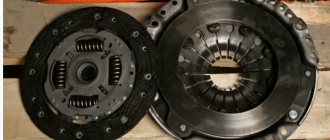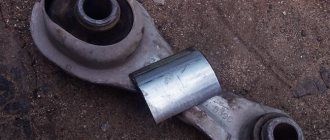Lada Vesta CNG is a modification that allows the use of two types of fuel: compressed natural gas (methane) and gasoline. One of the main advantages of this version is cost-effectiveness. We decided to find out what the real fuel consumption and range of the Lada Vesta with LPG is.
It is worth noting that when using gas, the system still consumes gasoline. This was done to reduce the combustion temperature of the mixture, which reduces the thermal effect on the engine when using gas. According to rough estimates, gasoline consumption is 1-1.5 l/100 km.
Fuel consumption from technical specifications
:
- Urban cycle, l/100 km — 10.1
- Urban cycle, m3/100 km - 8.1
- Extra-urban cycle, l/100 km — 6.0
- Extra-urban cycle, m3/100 km - 5.2
- Combined cycle, l/100 km - 7.5
- Combined cycle, m3/100 km - 6.3
How does it work?
A Vesta bifuel cylinder holds 90 liters, which corresponds to 21–22 cubic meters of gas (the exact volume value is determined by the density of the gas and the pressure in the filling column). The working pressure in the cylinder is 20 MPa at 15°C, and the test pressure reaches 30 MPa. Operating temperature range - from -40 to 55°C.
On a full gas charge, you can travel 300–400 km, and it will cost three times less than with gasoline. And since the 55-liter gas tank remained untouched, Vesta CNG can cover more than a thousand kilometers at one refueling with both types of fuel.
The possibilities for transforming the interior have been reduced to a minimum, but this Vesta travels 1000 kilometers without refueling.
The possibilities for transforming the interior have been reduced to a minimum, but this Vesta travels 1000 kilometers without refueling.
The cylinder ate up a fair share of the usable space of the 480-liter trunk. From it to the rear wall of the luggage compartment no more than five 1.5-liter bottles of mineral water will fit. This (based on the fact that the bottle diameter is 92 mm) is only 460 mm. A regular petrol Vesta has a trunk depth of 920 mm - twice as much. There is also almost no space left above the cylinder - well, you can squeeze in a couple of flat bags. By eye, the actual volume of the trunk has been reduced by almost half (there are no exact factory data yet).
A Chinese 90-liter cylinder holds 18–21 cubic meters. m of gas. Alas, its installation reduced the depth of the trunk by half.
A Chinese 90-liter cylinder holds 18–21 cubic meters. m of gas. Alas, its installation reduced the depth of the trunk by half.
The false floor covering the spare tire has also become half as long. Below that is a new tool tray that wraps around the spare tire, which is partially hidden by the cylinder. It's not scary: getting the spare tire is not much more difficult.
The steel gas pipeline is laid under the bottom and is not covered with anything from below - however, like the gasoline line. The gas pipeline goes under the hood to the receiver, which reduces the pressure and sends the gas further into the ramp, from where it is distributed to the injectors. Under the hood, on the left in the direction of travel, there is a controller that, in case of any unregulated gas consumption, shuts off its supply.
Metal composite cylinder - Chinese manufacturer Sinoma. They say it turned out to be the best in strength. Its guaranteed service life is 15 years, subject to re-examination every five years. The cylinder is clearly visible from the cabin when any part of the rear seat back is reclined - in fact, it blocked the entire opening, so it is now impossible to transport large loads. The valve is accessible from the passenger compartment: it must be closed if the machine is not used for a long period of time. The rest of the gas equipment is from the Italian company Emer.
The trunk area now looks like this. An empty plastic container rattles as it goes.
The trunk area now looks like this. An empty plastic container rattles as it goes.
The filling nipple is hidden under the gas tank flap next to the gasoline filler neck. Any Gazprom CNG filling station will give you an adapter that needs to be snapped onto the fitting. The adapters are mostly Western-made, but we have our own - Russian, more compact, but a little more difficult to use: before snapping it onto the fitting, it must be unscrewed. But in general, the refueling process is simple with any adapter: you need to snap it onto the fitting and insert the gun into it. I gave the money to the cash register and the gas started flowing.
Fully pumping a Vesta cylinder, in theory, takes 10 minutes, but we did it faster - it all depends on the pressure in the column.
What are the advantages of the methane version of Lada Vesta
The first samples of the modified car were presented by the plant in mid-2014 and caused a sensation due to the presence of a foreign-made factory gas installation and the possibility of using two fuel systems. Mass production of the model range started only in 2022.
The advantages of the methane version are:
- bringing the toxicity level to international standards;
- significant reduction in fuel costs (subject to the use of gas equipment);
- increasing the travel distance to 1000 km on a full tank;
- greater safety of methane compared to propane and butane;
- less wear of power plant mechanisms.
One of the main advantages, of course, is considered to be efficiency, especially when it comes to regular use of the car and driving long distances. This model has no external differences from the previous version, except for special markings in the trunk area, indicating that the car uses methane. Convenient for daily use, front-wheel drive sedans and station wagons are distinguished by a slightly higher price due to the dual-fuel system. However, economical fuel consumption and a lower price for methane offset this fact.
Is he going?
Judging by the passport data, when switching to gas, Vesta loses 11 hp. power and 15 Nm of torque. Acceleration to hundreds on gas takes 12.2 seconds, while on gasoline it takes 11.8. It is difficult to feel a decrease in power during measured driving. The VAZ-21129 engine fully retains its character, readily spinning up only after 3000 rpm. If you don’t drop the tachometer needle lower, the dynamics of the gas Vesta will satisfy everyone.
Filling fitting, cylinder and gas line leading under the hood. In addition to the receiver, which reduces the pressure to operating pressure, a controller has appeared in the engine compartment that monitors gas consumption. The gasoline tank located under the rear seat remains standard.
Filling fitting, cylinder and gas line leading under the hood. In addition to the receiver, which reduces the pressure to operating pressure, a controller has appeared in the engine compartment that monitors gas consumption. The gasoline tank located under the rear seat remains standard.
In most cases, it is possible to determine what fuel the car is running on only by the indicator above the switch button or during sudden starts from a standstill and during overtaking spurts, when a slight lack of traction is still noticeable. The engine starts always on gasoline (the gas reducer needs a little preliminary warming up), then you can switch to gas power. A forced transition (you need to press a button) from gas to gasoline and back takes a couple of seconds and is accompanied by a soft click of the valve behind the back of the rear seat. There is also automatic switching: if the gas cylinder is empty, the system itself will switch to gasoline power. But in some modes, even when driving on methane, gasoline consumption is small, about 1 l/100 km - it is injected in small doses into the cylinders to reduce the combustion temperature of the mixture and preserve the engine's life.
What is the difference between propane and methane. The principle of operation of a methane engine
Propane and methane are gas-fuel substances that have the same purpose, but fundamentally different characteristics. Propane is a product of the oil industry, while methane is classified as a natural gas. When used as fuel for HBO, both gases are placed in cylinders, the thickness of the walls of which also depends on the substance for which they are intended.
Liquefied propane does not require excessively high pressure when filling the cylinder; accordingly, the walls of the propane storage are not too dense (4-5 mm). Methane is used only in gaseous form, and its pressure reaches extremely high levels. Methane cylinders are much larger in size, their walls are strong (2-3 cm). During combustion, methane is harmless to the environment, which is why it is recognized by world standards as the most environmentally friendly combustible fuel. The most important difference between the two categories of gases is the degree of their safety for the driver and passengers of the car. Methane, unlike propane, is light, which allows the substance to evaporate (if it leaks) before creating an explosive situation. Since methane has no color or odor, the gas is diluted with specific odorants that make it possible to identify a leak. In Russia, the lion's share of car owners prefer installing propane gas equipment due to its lower cost and the relative lightness of fuel cylinders. Methane equipment is much more expensive, but the price of methane, its environmental friendliness and operational safety cover this disadvantage. A methane engine operates on the same principle as a gasoline engine (the compressed mixture is ignited by an energy source) with one fundamental difference - an increased level of compression. The fuel supply source is a gas cylinder, which is installed in the trunk of the car and is equipped with a special valve, through which both the equipment is refueled and gas is supplied to the system.
What about registration?
Vesta CNG is not a single car equipped with LPG, but a full-fledged serial modification, the first of its kind in Russia. The car has received vehicle type approval (VTA), it will have a factory warranty, an appropriately supplemented service book and a note in the vehicle title about a dual power system. Certification crash tests - frontal, side, rear impact - were passed successfully: there were no gas leaks in any of the tests, the gas equipment remained sealed.
On vehicles not equipped with LPG at the factory, the filler fitting is usually located under the hood. At the gas station, you need to open the gas supply, and after refueling, release the pressure. On the serial Vesta CNG refueling is much more reminiscent of a regular gasoline one.
On vehicles not equipped with LPG at the factory, the filler fitting is usually located under the hood. At the gas station, you need to open the gas supply, and after refueling, release the pressure. On the serial Vesta CNG refueling is much more reminiscent of a regular gasoline one.
When purchasing a car, registering it and further using it, no additional actions will be required from the owner. Inspection and maintenance of gas equipment are timed to coincide with routine maintenance, which Vesta undergoes every 15,000 km. All operations with gas equipment fall on the AVTOVAZ dealer network. According to forecasts, prices for maintenance will be only slightly higher than for gasoline cars, because the only significant operations (in addition to control and inspection) will be the regular change of the air filter cartridge.
Cost of installing LPG on Lada Vesta SW Cross 2022
according to the current price list
| BRC 4-cyl methane: | 41000 rub. |
| Cylinder (type 1) 39 l: | 15000 rub. |
| Cylinder (type 1) 39 l: | 15000 rub. |
| Cylinder (type 2) 90 l: | 44000 rub. |
| Mounting for cylinders: | 8000 rub. |
| Balloon valve: | 3000 rub |
| Balloon valve: | 5000 rub |
| Balloon valve: | 5000 rub |
| Gas level sensor: | 2500 rub. |
| TOTAL: | RUB 138,500 |
| —————————————- | |
| Promotion! HBO methane on 4-cyl. engine with 100 l cylinder : | 63000 rub |
Promotion from Gazprom for legal entities!
Payment for advertising a car with gas gas methane 65,000 rubles quarterly payments for 1 year
Where to refuel?
Now about the sad stuff. There are not many compressed natural gas filling stations in Russia - just over three hundred throughout the country (gasoline - over 25 thousand). But there is some progress: in 2016, 35 such stations were built, and this year it is planned to build twenty-five more.
There are currently four CNG filling stations in Moscow and St. Petersburg. The southern and Caucasian regions are of particular interest; the infrastructure there began to develop earlier - dealers are confident that there will be demand for Vesta CNG.
When refueling at a CNG filling station, you will be given an adapter that you need to snap onto the fitting under the hatch. Connect the dispenser hose to the other end and you can refuel.
When refueling at a CNG filling station, you will be given an adapter that you need to snap onto the fitting under the hatch. Connect the dispenser hose to the other end and you can refuel.
Prices and modifications of Lada Vesta on methane
At the present stage, the methane Lada Vesta is available in the following trim levels:
Comfort – manufacturers have added a number of additional functions to the basic configuration: expanded ability to adjust the driver’s seat, parking sensors, and a fairly powerful audio system. The price of the modification is about 640 thousand rubles.
The Luxe version includes power windows for the rear windows, additional side airbags, and sensors that respond to light and rain. Among other things, the version is equipped with alloy wheels with a diameter of 16 inches. For this modification, manufacturers ask from 700 thousand rubles.
Luxe Multimedia is the most expensive modification (from 730 thousand rubles). This version is equipped with a built-in navigation system, a 7-inch touch screen, six high-quality speakers, and multifunction steering.
When and how much?
Serial bi-fuel Vestas with a 1.6‑liter VAZ‑21129 engine and a 5-speed JR5 manual transmission will be aimed mainly at taxi work. Dealers have already started accepting orders. Several machines were handed over to potential customers for trial operation. It is planned to make about 600 cars this year; they will be sent to “various commercial structures” in the Moscow region and Tatarstan.
If the regular Vesta 1.6 in the Classic + Start version costs 570,900 rubles, then the CNG version will cost 600,900 rubles. Meanwhile, re-equipping a car at the factory costs 170,000 rubles! Of these costs, the state compensates the manufacturer for 140,000 rubles, so the end consumer overpays only 30,000 rubles, which can be “recovered” quite quickly with active use.
Vesta CNG Comfort is priced at 628,900 rubles, Vesta CNG Lux - at 691,900, and Vesta CNG Luxe + MMS - at 715,900 rubles.
The market is eagerly awaiting the bi-fuel Largus CNG, which is often used for commercial transportation, but it will only arrive next year.
Lada Vesta 1.6 CNG and petrol Vesta 1.6
| Automobile | Power | Moment | Acceleration to 100 km/h | Fuel consumption: combined cycle |
| Vesta 1.6, manual transmission | 106 hp | 148 Nm | 11.8 s | 6.9 l/100 km |
| Vesta 1.6 CNG, manual transmission | 95 hp | 133 Nm | 12.2 s | 6.2 m³/100 km* |
*When driving on gas.
Bi-fuel Lada Vesta - test drive ZR
Technical characteristics of Lada Vesta on methane
Lada Vesta CNG is equipped with a 1.6 liter dual-fuel engine and a five-speed manual transmission. The maximum speed when using gasoline is 175 km/h, gas – 170 km/h. The power of the power plant when driving on gasoline is 106 kW. When switching to methane, the figures drop to 96 kW.
The gas fuel refill compartment is located directly behind the gas tank hatch. The modified version of the car is equipped with a factory-installed Italian-made gas system; a 90-liter gas cylinder is located behind the rear seats. To increase the safety level of the tank, the cylinder is equipped with high-speed valves and a special fuse that prevents it from rupture and methane leakage. This arrangement of the volumetric cylinder significantly reduced the available space in the luggage compartment and made it impossible to transform the rear row of seats. Significant advantages were the absence of the need for maintenance of the gas reducer, fuel rail and the long service life of the cylinder (15 years). When ignited, this model uses exclusively gasoline fuel, after which the vehicle automatically switches to gas. Manufacturers have provided another important automated process - switching from gasoline to methane, in the case of the end of the former in the tank. The Lada Vesta functionality includes the ability to manually switch work from gasoline to gas and vice versa. The car accelerates to a speed of 100 km/h (when using gasoline) in 11.8 seconds. methane slightly increases these figures to 13c. The average methane consumption is 6.3 m3. Otherwise, the modified model is no different from its predecessor.
Registration of the methane version of Lada Vesta with the Traffic Police
Lada Vesta CNG is a model range serially modified for LPG. The registration procedure for the methane version of the Lada Vesta does not differ significantly from the registration of the gasoline version. The vehicle's passport must initially contain a note stating that the car's engine is dual-fuel, but the registration certificate (CTC) may not contain a record of gas equipment. However, it is better for the car owner to insist that the STS and special notes must include a clause regarding the presence of LPG.
